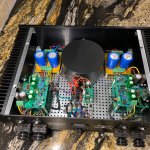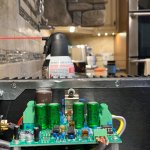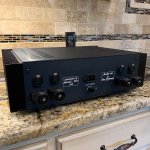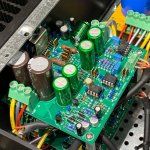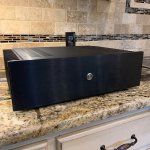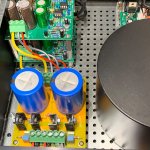@mkane77gOh, yes. You can always stack the amp channels if you run out of floorspace. I prefer long threaded female-female standoffs for this. www.mcmaster.com is your friend in need (though not a very cheap friend).
TOm
An idea I implemented years ago for an older design called the Parallel 86. See attached. It’s fine in regular music use due to the crest factor but I wouldn’t challenge it with long bouts of sine wave testing.
Best,
Anand.
Attachments
LM3886 typically doesn't need a whole lot of heat sinking (compared to the class A amps in the diyAudio forum), so the use case affects what's 'better.'
My Modulus86 has modest heatsinks with Keratherm, and the sinks barely warm up.
This thread has a lot of good info:
My Modulus86 has modest heatsinks with Keratherm, and the sinks barely warm up.
This thread has a lot of good info:
Edit 15/01/2025: I have an updated version of the Thermal Pad Tests pdf, which includes some extra stuff. See post 18.
Thought Id share the results from some tests I did recently after getting myself into trouble!
I hope it may be of some use.
Thought Id share the results from some tests I did recently after getting myself into trouble!
I hope it may be of some use.
Fearless Amp Building! Looks like fun. I assume you don't have roaming pets or children.
However, I'd be leery of series-connecting two SMPS that are different models.
However, I'd be leery of series-connecting two SMPS that are different models.

I’m just using what I had. Ones an LS 600, the other SE 600. Both 36vdc turned down to 32. Both big and bulky. Kids left the house 35 years ago. Both cats are still alive.
A 3U case is on the way. Different PS in the works.
A 3U case is on the way. Different PS in the works.
There's a lot of thermal mass in those heat sinks. Using two channels of Parallel-86 on the same heat sink would probably take the better part of an hour to heat up the heat sink enough that you'd need to be concerned about reaching the thermal limits of the LM4780.It’s fine in regular music use due to the crest factor but I wouldn’t challenge it with long bouts of sine wave testing.
Maybe. Check the data sheet. They might offer lower thermal resistance, so that'll make the LM3886 run cooler, which I'm always in favour of. But as noted by others the heat sinks in a 2U x 300 mm chassis barely get above room temperature even after a long, 'spirited' listening session, so obsessing over thermal pads seems to be a case of gilding the lily.Is ceramic a better choice?
Tom
Yeah, that PSU arrangement doesn't instill much confidence. 😉 Sounds like it's a temp solution.Fearless Amp Building! Looks like fun. I assume you don't have roaming pets or children.
However, I'd be leery of series-connecting two SMPS that are different models.
Isn't one of those supplies an SE-series? Unless it's modified, that means it has a rather loud fan in it, which further tells me that it's a temporary solution. The plywood plinth is a pretty good indicator too, but I'm not here to judge. Perhaps we can forgive the use of different SMPSes in a prototype setup. 😉
Tom
Tom
3U arrived. Waiting for stand offs. Local hardware store had none. Drill press is out, bits at the ready. I need a smaller tap handle.
PS will be a Connex 800Re -/+32vdc. This unit has a built in soft start along with a few other bells & whistles. Hoping it alleviates my turn on/off pop.
Wish me luck.
PS will be a Connex 800Re -/+32vdc. This unit has a built in soft start along with a few other bells & whistles. Hoping it alleviates my turn on/off pop.
Wish me luck.
Were up and running.
Tweets & mids in the 3U, bass bin monos in the silver enclosures. I’ll get a pair of 90 deg. IEC’s.
The clarity of the eighty sixes is wonderful. These modules seem immune to noise intrusion.

Tweets & mids in the 3U, bass bin monos in the silver enclosures. I’ll get a pair of 90 deg. IEC’s.
The clarity of the eighty sixes is wonderful. These modules seem immune to noise intrusion.
And I’m still stuck in front of this amp.
One question if I may. How hot is too hot on the heatsinks? My ir temp gauge says 50C.

One question if I may. How hot is too hot on the heatsinks? My ir temp gauge says 50C.
That's comfortable.How hot is too hot on the heatsinks? My ir temp gauge says 50C.
Even with a worst case estimate for the thermal resistance from the LM3886 to the heat sink, you can go up to 70 ºC for continuous sine wave operation. The over-temperature protection in the IC will then kick in once the heat sink temperature reaches 85 ºC.
I hope it goes without saying that 70-85 ºC is way too hot for an external heat sink. I generally design for 60 ºC. There aren't really standards in this area, but one standard one could look at is the standards that cover kitchen appliances. For those, a maximum temperature of 65 ºC is allowed on a control surface (i.e., knobs and such). So I'd say that you should stay below 65 ºC for the heat sink.
I once ran an LM3886 on a heat sink from a Pentium CPU. The heat sink reached about 110 ºC but the IC kept going. I wouldn't recommend doing that, but it does show that the IC is pretty rugged.
Tom
Theres a build here that used some type of fast on plugged into the terminal blocks.
I’ll keep looking.
I’ll keep looking.
There is a pluggable version of the terminal blocks. It's not an exact fit, but the pin pitch is the same and it will fit on the board.
Plug: TE P/N: 284507-3
Receptacle: TE P/N: 284517-3
Tom
Plug: TE P/N: 284507-3
Receptacle: TE P/N: 284517-3
Tom
- Home
- Vendor's Bazaar
- Modulus-86: Composite amplifier achieving <0.0004 % THD+N.
